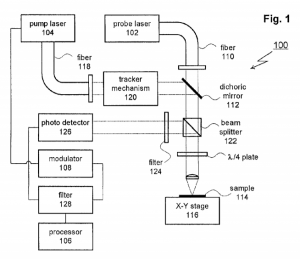 On Friday, June 15th, the Court of Appeals for the Federal Circuit denied a petition for panel rehearing and rehearing en banc in Xitronix Corporation v. KLA-Tencor Corporation. The petition for rehearing was filed by KLA-Tencor after the Federal Circuit first decided Xitronix back in February of this year, where the appellate court held that it didn’t have jurisdiction to hear an appeal in a patent case which only involved claims of monopolization under U.S. Supreme Court standards set in 1965’s Walker Process Equipment v. Food Machinery & Chemical Corp.
On Friday, June 15th, the Court of Appeals for the Federal Circuit denied a petition for panel rehearing and rehearing en banc in Xitronix Corporation v. KLA-Tencor Corporation. The petition for rehearing was filed by KLA-Tencor after the Federal Circuit first decided Xitronix back in February of this year, where the appellate court held that it didn’t have jurisdiction to hear an appeal in a patent case which only involved claims of monopolization under U.S. Supreme Court standards set in 1965’s Walker Process Equipment v. Food Machinery & Chemical Corp.
 This case stems back to a complaint filed by Xitronix against KLA-Tencor in the Western District of Texas back in December 2014. The suit raised claims of antitrust violations under the Sherman Act and the Clayton Act against KLA-Tencor on allegations that KLA-Tencor was attempting to monopolize interstate and foreign commerce by fraudulently prosecuting certain patent claims at the U.S. Patent and Trademark Office. Xitronix’s claims of fraudulent prosecution surround U.S. Patent No. 8817260, titled Modulated Reflectance Measurement System Using UV Probe. Issued to KLA-Tencor in August 2014, it covers a method for evaluating a silicon semiconductor sample in a way that increases the accuracy and flexibility of systems using photomodulated reflectivity to analyze semiconductor wafers.
This case stems back to a complaint filed by Xitronix against KLA-Tencor in the Western District of Texas back in December 2014. The suit raised claims of antitrust violations under the Sherman Act and the Clayton Act against KLA-Tencor on allegations that KLA-Tencor was attempting to monopolize interstate and foreign commerce by fraudulently prosecuting certain patent claims at the U.S. Patent and Trademark Office. Xitronix’s claims of fraudulent prosecution surround U.S. Patent No. 8817260, titled Modulated Reflectance Measurement System Using UV Probe. Issued to KLA-Tencor in August 2014, it covers a method for evaluating a silicon semiconductor sample in a way that increases the accuracy and flexibility of systems using photomodulated reflectivity to analyze semiconductor wafers.
According to Xitronix, the ‘260 patent was fraudulently procured by KLA-Tencor after intentional and willful misrepresentations and omissions made by KLA-Tencor attorney Michael Stallman prosecuting the ‘260 patent at the USPTO. Such omissions involved the fact that claim 1 of the ‘260 patent was identical to claims which had been previously invalidated by a district court judge in a prior patent infringement battle between Xitronix and KLA-Tencor. Xitronix alleges that claim 1 of the ‘260 patent is essentially the same as claim 9 of U.S. Patent No. 7362441, same title as the ‘260 patent, which had been found invalid on 35 U.S.C. § 112 grounds for indefiniteness. Xitronix alleges that the only material difference of the invalidated claim 9 from the ‘441 patent and claim 1 of the ‘260 patent is that the ‘260 patent claim 1 dropped a limitation from the invalidated ‘441 patent claim 9, a limitation which wasn’t practiced by Xitronix.
By fraudulently obtaining the ‘260 patent, Xitronix alleged that KLA-Tencor is trying to prevent Xitronix from operating in the industry of optical inspection for semiconductor manufacturing. After Xitronix introduced a new photo-modulated reflectance technology to the dopant activation metrology market in 2007, the company alleged that Stallman drafted new claims into the patent application for the ‘441 patent to cover this new technology. The ‘441 patent issued in 2008 and by 2012, KLA-Tencor controlled about 80 percent of the market for optical inspection of semiconductor wafers. Once the ‘441 patent’s claim 9 was invalidated, in a case in which Stallman was involved, Stallman allegedly did not direct the examiner of the ‘260 patent to this information which was pertinent given the similarities to the invalidated claim in the ‘441 patent. This has had a material effect on Xitronix’s semiconductor inspection business as potential investors have withdrawn their interest in investing after learning about the threat of litigation from KLA-Tencor.
In an order on summary judgement entered by U.S. District Judge Sam Sparks in August 2016, the district court found that Xitronix had failed to show a fact issue existing as to whether Stallman made fraudulent representations and omissions during the prosecution of the ‘260 patent. Xitronix appealed the decision to the Federal Circuit, citing both 28 U.S.C. § 1295(a)(1) and the Federal Circuit’s 1998 decision in Nobelpharma AB v. Implant Innovations, Inc. to support its argument that the Federal Circuit had jurisdiction to hear the appeal and not the Court of Appeals for the Fifth Circuit, the regional circuit to which Western Texas cases are appealed. KLA-Tencor did not argue against Xitronix’s argument on the Federal Circuit’s jurisdiction in this case.
The Federal Circuit’s February decision in Xitronix, which was argued in front of a panel consisting of Circuit Judges Kimberley Moore, Haldane Mayer and Todd Hughes, held that the Federal Circuit did not have jurisdiction in this appeal and that the ase should be transferred to the Fifth Circuit. Prior to oral arguments, the Federal Circuit had asked both sides to show cause supporting the argument that the case shouldn’t be transferred in light of Supreme Court precedent set in Gunn v. Minton, a 2013 case which found that the Federal Circuit does not have exclusive jurisdiction in case appeals involving patent law when the patent issue is not the primary issue in the case. Gunn arose from a case involving allegations of legal malpractice in the handling of a patent case, a state malpractice claim which was not covered by federal patent law.
“There is nothing unique to patent law about allegations of false statements,” reads the opinion authored by Judge Moore. In response to the appellate court’s order to show cause, both parties cited portions of the complaint which focused on fraud and misrepresentation, not patent law. Although a determination of the alleged misrepresentations to the USPTO would almost certainly require some application of patent law, the Federal Circuit held that the underlying issue in the case did not raise a substantial issue of patent law.
Dissenting from the Federal Circuit’s more recent decision to deny a petition for en banc rehearing of Xitronix were Circuit Judges Alan Lourie and Pauline Newman, the latter of which penned a dissenting opinion on the petition’s denial. “I write because of the importance of this decision to the judicial structure of patent adjudication, and the future of a nationally consistent United States patent law,” Newman’s dissent begins. Newman argued that the Federal Circuit’s jurisdictional ruling is contrary to the statute governing the Federal Circuit, creating concerns and uncertainties in jurisdiction between the Federal Circuit and the regional circuit courts. Because the district court’s decision was limited to patent issues, the case involved issues of patent validity and enforceability which should have been heard by the Federal Circuit despite the nature of the allegations as Walker Process claims. If the Federal Circuit was going to change precedent on the jurisdiction of patent cases involving Walker Process claims, it should have done so through an en banc rehearing, Newman argues. Further, the panel decision contravenes Supreme Court and Federal Circuit precedent set in cases such as 1988’s Christianson v. Colt Industries, and misconstrues regional circuit rulings on jurisdiction in antitrust actions involving issues of patent law.
Judge Newman argued four points as to why en banc rehearing was appropriate and necessary in this case: the panel raised jurisdiction questions on Walker Process appeals at its own initiative; precedent is contrary to the panel’s rejection of the appeal, even under Gunn; the reason for formation of the Federal Circuit was to stabilize and provide uniformity to federal patent law; and that appellate review of cases arising under patent law is the assignment and obligation of the Federal Circuit.

![[IPWatchdog Logo]](https://ipwatchdog.com/wp-content/themes/IPWatchdog%20-%202023/assets/images/temp/logo-small@2x.png)

![[[Advertisement]]](https://ipwatchdog.com/wp-content/uploads/2023/01/2021-Patent-Practice-on-Demand-1.png)
![[Advertisement]](https://ipwatchdog.com/wp-content/uploads/2024/04/UnitedLex-May-2-2024-sidebar-700x500-1.jpg)
![[Advertisement]](https://ipwatchdog.com/wp-content/uploads/2024/04/Artificial-Intelligence-2024-REPLAY-sidebar-700x500-corrected.jpg)
![[Advertisement]](https://ipwatchdog.com/wp-content/uploads/2024/04/Patent-Litigation-Masters-2024-sidebar-700x500-1.jpg)

![[Advertisement]](https://ipwatchdog.com/wp-content/uploads/2021/12/WEBINAR-336-x-280-px.png)
![[Advertisement]](https://ipwatchdog.com/wp-content/uploads/2021/12/2021-Patent-Practice-on-Demand-recorded-Feb-2021-336-x-280.jpg)
![[Advertisement]](https://ipwatchdog.com/wp-content/uploads/2021/12/Ad-4-The-Invent-Patent-System™.png)






Join the Discussion
No comments yet.